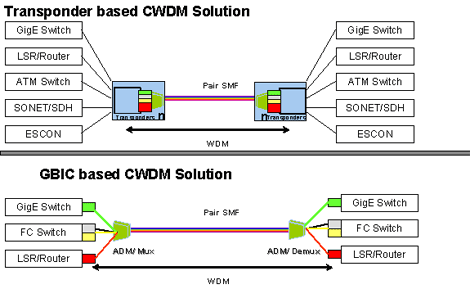Transmode, Cisco Duel on CWDM
Is a David vs Goliath battle shaping up in the coarse wavelength-division multiplexing market?
July 22, 2003

The next step forward in the market for coarse wavelength-division multiplexing (CWDM) technology could feature something of a David and Goliath battle, judging by developments today.
It started with David -- Transmode Systems AB, a Swedish CWDM equipment pioneer -- announcing some new products (see Transmode Broadens CWDM Portfolio).
But it got a lot more interesting when Goliath -- Cisco Systems Inc. (Nasdaq: CSCO) -- hove into view, stomped on the little startup (squelch!), and let it slip that it's got some new CWDM developments of its own in the pipeline (burp!).
The scuffle is over Transmode's new "Pluggable Transponder," a module that plugs into customer equipment to offer carriers a cheaper way of offering managed, CWDM-based services.
Unfortunately for Transmode, a lot of that customer equipment happens to have a Cisco label on it, and Cisco says it probably won't support the use of Transmode modules with its gear.
Cisco's got a valid reason: such modules need to undergo a lot of interoperability tests to demonstrate that they'll meet electromagnetic compatibility (EMC) regulations, according to Martin Patten, manager of product marketing for Cisco's Catalyst switches in Europe, Middle East, and Africa (EMEA).
All the same, it could be a handy excuse for Cisco, which already sells pluggable CWDM modules for its equipment -- and charges a hefty price for them. Patten cites a list price of $4,995. Transmode says its modules will probably list between $1,500 and $2,000 apiece when they ship at the end of the year.
Transmode's modules aren't just a lot less expensive than Cisco's. They also do more because, unlike Cisco's, they enable carriers to manage the optics. Patten questions whether that's really necessary. "What do you actually need to manage, anyhow?" he asks, noting that many CWDM parts are passive and can't go wrong.
This view is challenged by one of Transmode's customers, Vtesse Networks, a U.K. startup network operator offering Ethernet-based services to corporate customers. Its CTO, Alan Mitchell, cites lack of management as a key reason why he's not used Cisco type modules in his network. "You'd have no idea what was happening to the transmission system," he says.
Cisco's Patten isn't convinced and thinks the EMC issue will prove a big problem for Transmode. "All of the other vendors will have similar issues," he says. Michael Crossey, Transmode's VP of marketing, says other vendors are discussing interoperability tests. They're interested in selling Transmode's modules because it'll give them a competitive advantage over Cisco, he contends.
To dig deeper in this issue, a little background is needed on the two types of CWDM system that have been sold to date.
Transmode has pioneered the "transponder-based" approach, whereby each piece of customer equipment is connected using inexpensive 850 or 1310 nanometer optics to a transponder that converts the incoming light back into electrical signals before retransmitting it at one of the standard wavelengths used in the CWDM system (between 1270 and 1610nm). Cisco has championed the "GBIC-based" approach, whereby vendors offer a range of Gigabit Interface Converters (GBICs) that plug directly into customer equipment and convert electrical signals directly into one of the standard CWDM wavelengths. This skips the need for an expensive transponder.
Cisco has championed the "GBIC-based" approach, whereby vendors offer a range of Gigabit Interface Converters (GBICs) that plug directly into customer equipment and convert electrical signals directly into one of the standard CWDM wavelengths. This skips the need for an expensive transponder.
So far, telecom operators have often preferred the transponder-based approach because it enables them to manage their networks and handle equipment with non-GBIC interfaces. Enterprises have favored the GBIC approach because it's simple and low cost (see CWDM: Low-Cost Capacity).
Transmode's new "Pluggable Transponders" plug directly into interfaces in customer equipment (like the GBIC-based approach) but incorporate all of the componentry found in its transponder cards, giving carriers the ability to offer managed services.
"The way it's been implemented keeps the cost down -- and that's the bit that's protected by patents," says Transmode's Crossey. As noted, the Pluggable Transponders will list at $1,500 to $2,000 each. This compares with $3,000 to $5,000 for Transmode's transponder card.
Brian McCann, chief marketing and strategy officer for one of Transmode's competitors, ADVA AG Optical Networking (Frankfurt: ADV), questions whether there's a big market for GBIC format devices now. Something like 10 million GBIC ports have been deployed in customer equipment, according to Cisco, but "most of the new equipment is starting with SFP [Small Form Pluggable]," McCann contends, adding that in ADVA's experience, customers deploy new equipment when they buy CWDM-based services.
McCann also wonders whether Transmode's device will be totally GBIC compatible, bearing in mind that it's incorporating extra functions that would boost power requirements and might need extra pins.
Crossey says Transmode's module fully complies with the GBIC multisource agreement. "The electrical side of it is unchanged." He accepts that new equipment now boasts SFP interfaces. "It's the installed base we're targeting to start with." Transmode will bring out SFP modules "hot on the heels" of its GBIC ones, early next year, he adds.
By then, however, Cisco might have shifted the goal posts. "We already offer CWDM GBICs and DWDM GBICs," says Patten. The next step, he hints, will be CWDM SFP modules.
— Peter Heywood, Founding Editor, Light Reading
You May Also Like










